16.04.2020
New Comet SWAN brightens, while Comet ATLAS continues to fragment and Comet PanSTARRS holds steady.
There's a lot happening in the northern sky these days, namely lots of comets! Comet ATLAS (C/2019 Y4) is still worth watching, but look for the new Comet SWAN (C/2020 F8) and Comet ATLAS (C/2019 Y1). And you can still catch a glimpse of our old friend, Comet PanSTARRS (C/2017 T2) .
COMET CRAZY
Comet ATLAS (C/2019 Y4) continues to shed fragments while slowly fading and becoming more diffuse. But it ain't dead yet!
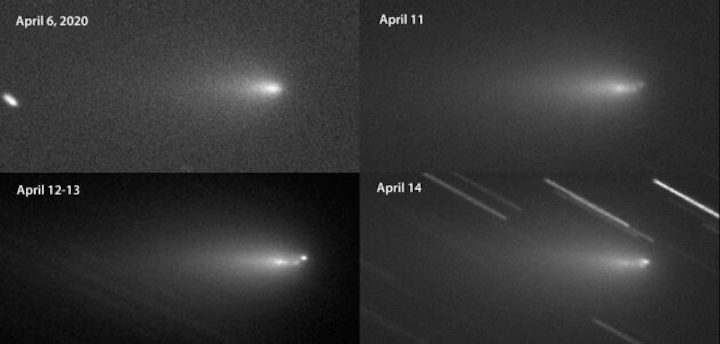
The evolution of Comet ATLAS's fragmenting pseudo-nucleus is clearly visible in these images taken between April 6th and 14th. The brightest fragment situated off-axis from the other pieces may be the original nucleus. In the final frame note that it has developed a tiny tail of its own. North is up.
Gianluca Masi and Nick Haigh
Observers are still spotting the crumbling object in 100-mm binoculars and (dimly) in 6-inch telescopes under dark skies. On April 14th at 3h UT the comet's overall magnitude had faded to 9.4, but striking changes have occurred within the inner coma. The nuclear region is now clearly elongated east-to-west with hints of fuzzy condensations visible along its length, using magnifications upward of 300× and averted vision.
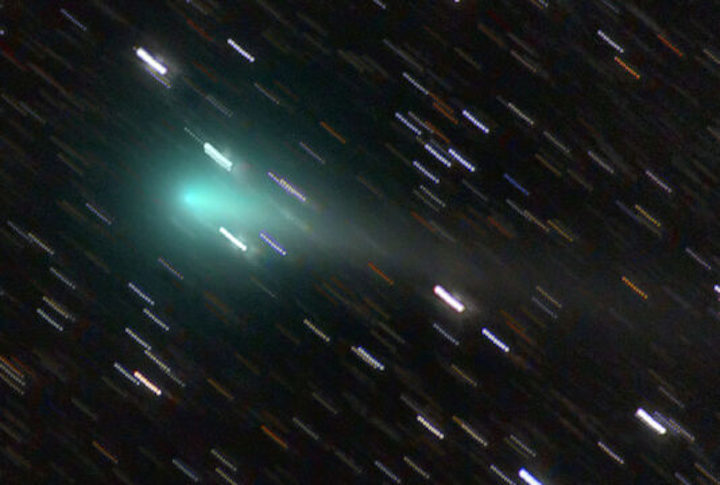
In a recent development, Comet ATLAS displays a lengthening tail seen in this image taken on April 14th. Chris Schur
On two recent evenings I was able to momentarily catch sight of the brightest fragment (pictured above) along with one or two additional fuzzy stellarings, faint starlike objects that appear on a nebulous object, in my 15-inch Dob at 400×. I encourage observers with larger telescopes to seek these amazing nuggets out. How often do we get the opportunity to see a comet come apart?
The coma measured 4′ across on April 14 at 3h UT, but when I added a Swan filter, which enhances emissions from gassy comets, Comet ATLAS brightened relative to the background sky and the coma expanded to 5′. Although I spotted the comet faintly in 10×50 binoculars on April 1oth, it was invisible on April 13th. This chart (black-and-white PDF here) is still good for locating ATLAS through late April. Assuming the comet soldiers on I'll update the chart next week.
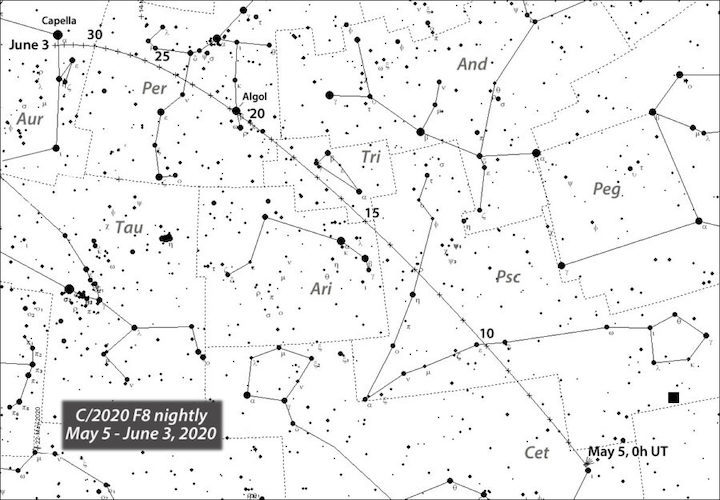
SkyMap software
NEW COMET TO THE RESCUE
Meanwhile, Michael Mattiazzo of Australia has found a new comet named Comet SWAN (C/2020 F8) in imagery taken by the Solar Wind ANisotropies (SWAN) camera on the Solar and Heliospheric Observatory (SOHO) and publicly available here.
Comet SWAN is presently 8th magnitude, compact, and brightening steadily as it plows across Piscis Austrinus at dawn for Southern Hemisphere observers. Soon it will swing northward, making its first appearance in Aquarius at 7th magnitude for southern U.S. observers by month's end.
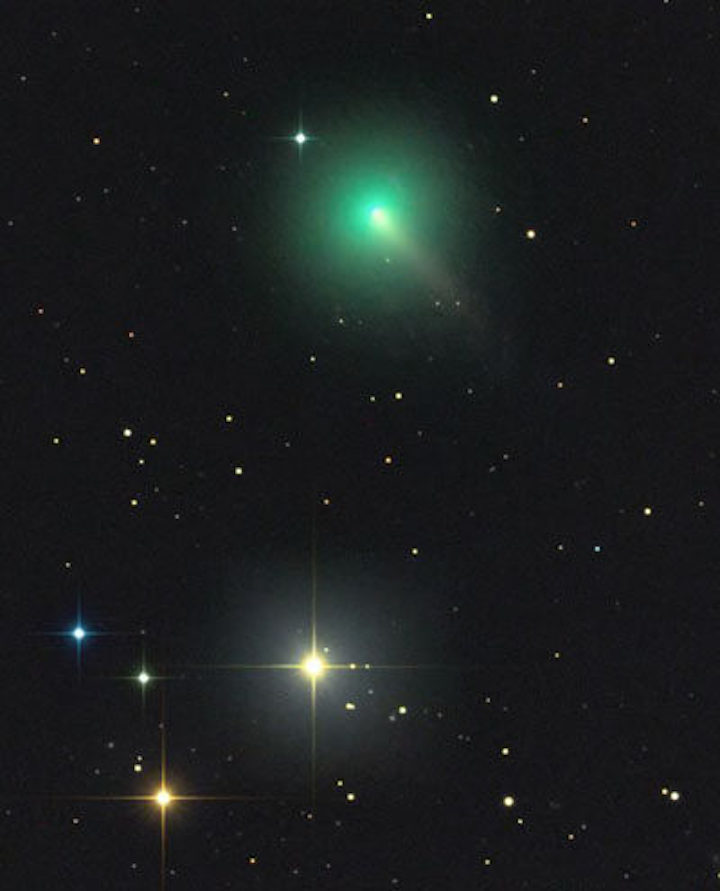
Rolando Ligustri
Comet SWAN (C/2020 F8) will continue to brighten and move rapidly northward in the May dawn sky reaching a peak magnitude of 3.5 between May 15–23 while racing from Triangulum across Perseus. Though bright, the comet remains low in the northeastern sky at the start of dawn throughout the best part of its apparition. Amazingly, Comet SWAN arrived just in time to pinch-hit for ATLAS in the event that comet disintegrates completely. It even reaches peak brightness in the same area of the sky. Perihelion occurs on May 27th at a distance of 64.3 million kilometers.
COMET PANSTARRS HOLDS STEADY
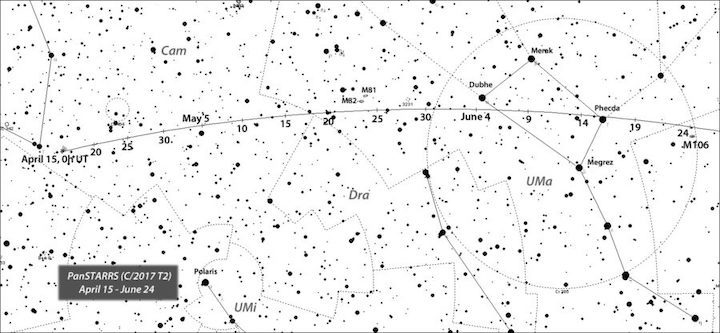
Comet PanSTARRS should hold steady at 8th magnitude as it arcs toward the Bowl of the Big Dipper this spring. Positions are marked every five days with stars to magnitude 8.
SkyMap
Our final comet, a steady and reliable performer thus far, has taken a back seat in light of all the excitement about naked-eye and disintegrating comets — Comet PanSTARRS (C/2017 T2). It's doing just fine, thank you, as it plies a path across Camelopardalis toward the Big Dipper. From dark skies it's relatively easy to see in 10×50 binoculars at magnitude 8.5. Through my 15-inch on April 11th at 2h UT at 64× I saw a strongly condensed 3.5′ coma with a broad 9′ tail pointing southeast.
ANOTHER ATLAS COMET?
... and that's not all. A second ATLAS comet has shown remarkable staying power. Discovered on December 16, 2019, Comet ATLAS (C/2019 Y1) began life as an 18th magnitude blip. It gradually brightened to around magnitude 9.5 by early March while crossing the Great Square of Pegasus low in the western sky at dusk. Perihelion occurred on March 15th.
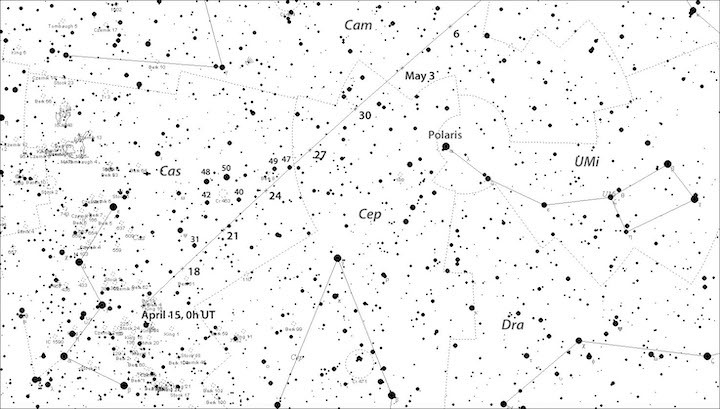
Map showing Comet ATLAS (C/2019 Y1) travels from Cassiopeia across Camelopardalis between April 15th and May 6th. Stars shown to magnitude 8. SkyMap
Although expected to fade this month, ATLAS Y1 has remained stubbornly bright. I was frankly surprised when I turned my 15-inch scope toward the comet on April 16.12 UT. At 64x it displayed a strongly condensed, 3′ pale green coma and a faint, north-pointing tail. I had no trouble spotting it in 10x50 binoculars.
Like Comet PanSTARRS and Comet ATLAS Y4, Y1 is a circumpolar object and visible all night long from mid-northern latitudes. Expect the comet to slowly fade as it travels from Cassiopeia through Ursa Minor — passing 6.5° above Polaris on the night of May 1 — and onward to the Big Dipper. Closest approach to Earth at 1.1 a.u. occurs on May 3rd.
So much is happening in the sky right now. Grab your scope and hop on a comet (or four!) the next clear night.
